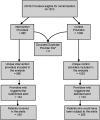Randomized clinical trial of a customized electronic alert requiring an affirmative response compared to a control group receiving a commercial passive CPOE alert: NSAID--warfarin co-prescribing as a test case
- PMID: 20595308
- PMCID: PMC2995662
- DOI: 10.1136/jamia.2009.000695
Randomized clinical trial of a customized electronic alert requiring an affirmative response compared to a control group receiving a commercial passive CPOE alert: NSAID--warfarin co-prescribing as a test case
Abstract
Background: Studies that have looked at the effectiveness of computerized decision support systems to prevent drug-drug interactions have reported modest results because of low response by the providers to the automated alerts.
Objective: To evaluate, within an inpatient computerized physician order entry (CPOE) system, the incremental effectiveness of an alert that required a response from the provider, intended as a stronger intervention to prevent concurrent orders of warfarin and non-steroidal anti-inflammatory drugs (NSAIDs).
Design: Randomized clinical trial of 1963 clinicians assigned to either an intervention group receiving a customized electronic alert requiring affirmative response or a control group receiving a commercially available passive alert as part of the CPOE. The study duration was 2 August 2006 to 15 December 2007.
Measurements: Alert adherence was compared between study groups.
Results: The proportion of desired ordering responses (ie, not reordering the alert-triggering drug after firing) was lower in the intervention group (114/464 (25%) customized alerts issued) than in the control group (154/560 (28%) passive alerts firing). The adjusted OR of inappropriate ordering was 1.22 (95% CI 0.69 to 2.16).
Conclusion: A customized CPOE alert that required a provider response had no effect in reducing concomitant prescribing of NSAIDs and warfarin beyond that of the commercially available passive alert received by the control group. New CPOE alerts cannot be assumed to be effective in improving prescribing, and need evaluation.
Conflict of interest statement
Figures
References
-
- Kohn LT, Corrigan JM, Donaldson MS, eds. (Committee on Quality of Health Care in America, Institute of Medicine). To Err Is Human: Building a Safer Health System. Washington, DC, USA: National Academies Press, 1999 - PubMed
-
- Bates DW, Leape LL, Cullen DJ, et al. Effect of computerized physician order entry and a team intervention on prevention of serious medication errors. JAMA 1998;280:1311–16 - PubMed
-
- Teich JM, Merchia PR, Schmiz JL, et al. Effects of computerized physician order entry on prescribing practices. Arch Intern Med 2000;160:2741–7 - PubMed
Publication types
MeSH terms
Substances
Grants and funding
LinkOut - more resources
Full Text Sources
Medical


